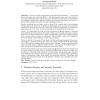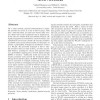69 search results - page 13 / 14 » Surviving attacks on disruption-tolerant networks without au... |
ACC
2011
12 years 5 months ago
2011
On May 5, 2010 the last step of the DNSSEC deployment on the 13 root servers was completed. DNSSEC is a set of security extensions on the traditional DNS protocol, that aim in prev...
CCS
2008
ACM
13 years 7 months ago
2008
ACM
When users run a group key exchange (GKE) protocol, they usually extract the key from some auxiliary (ephemeral) secret information generated during the execution. Strong corrupti...
JUCS
2008
13 years 5 months ago
2008
: As soon as major protocol flaws were discovered empirically -- a good luck that is not older than the early 1990s -- this title question came up to the world. It was soon realise...
IJNSEC
2006
13 years 5 months ago
2006
On a wired network, physical authentication is implicitly provided by access: if a user is able to plug a cable into a network socket, he must have cleared other security checks s...
SP
2009
IEEE
14 years 5 days ago
2009
IEEE
– HTTPS is designed to provide secure web communications over insecure networks. The protocol itself has been rigorously designed and evaluated by assuming the network as an adve...


